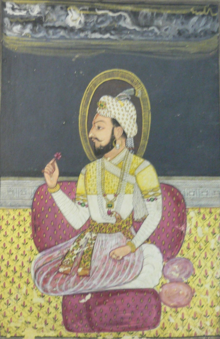
Back Sambhaji German Sambhaji Spanish Sambhaji French सम्भाजी HI Sambhaji ID サンバージー Japanese ಸಂಭಾಜಿ KN സംഭാജി ഭോസ്ലെ Malayalam संभाजी महाराज MR Sambhaji (chhatrapati) Dutch
| Sambhaji | |
|---|---|
| Maharaja Chhaava (Lion's Cub) Swarajya Rakshak (Defender of Self rule) | |
 A painting of Sambhaji, late 17th century | |
| Chhatrapati of the Marathas | |
| Reign | 16 January 1681 – 11 March 1689 |
| Coronation | 20 July 1680, Panhala (symbolic) or 16 January 1681, Raigad fort (official) |
| Predecessor | Shivaji I |
| Successor | Rajaram I |
| Peshwa | |
| Born | 14 May 1657 Purandar Fort, Ahmadnagar Subah, Mughal Empire (present-day Pune district, Maharashtra, India) |
| Died | 11 March 1689 (aged 31) Tulapur, Ahmadnagar Subah, Mughal Empire (present-day Pune district, Maharashtra, India) |
| Cause of death | Execution by decapitation |
| Spouse | Yesubai |
| Issue | Bhavani Bai Shahu I |
| House | Bhonsale |
| Father | Shivaji I |
| Mother | Saibai |
| Religion | Hinduism |
Sambhaji (Sambhaji Bhonsle, Marathi pronunciation: [saːmˈbʱaːdʑiː ˈbʱos(ə)le]; c.14 May 1657 – 11 March 1689), also known as Shambhuraje, was the second Chhatrapati of the Maratha Empire, ruling from 1681 to 1689. He was the eldest son of Shivaji, the founder of the Maratha Kingdom. Sambhaji's rule was largely shaped by the ongoing wars between the Marathas and the Mughal Empire, as well as other neighbouring powers such as the Abyssinians of Janjira, Wadiyars of Mysore and the Portuguese Empire in Goa. After Sambhaji's execution by Aurangzeb, his brother Rajaram I succeeded him as the next Chhatrapati and continued the Mughal–Maratha Wars.[1]
- ^ Sen, Sailendra (2013). A Textbook of Medieval Indian History. Primus Books. pp. 199–200. ISBN 978-93-80607-34-4.